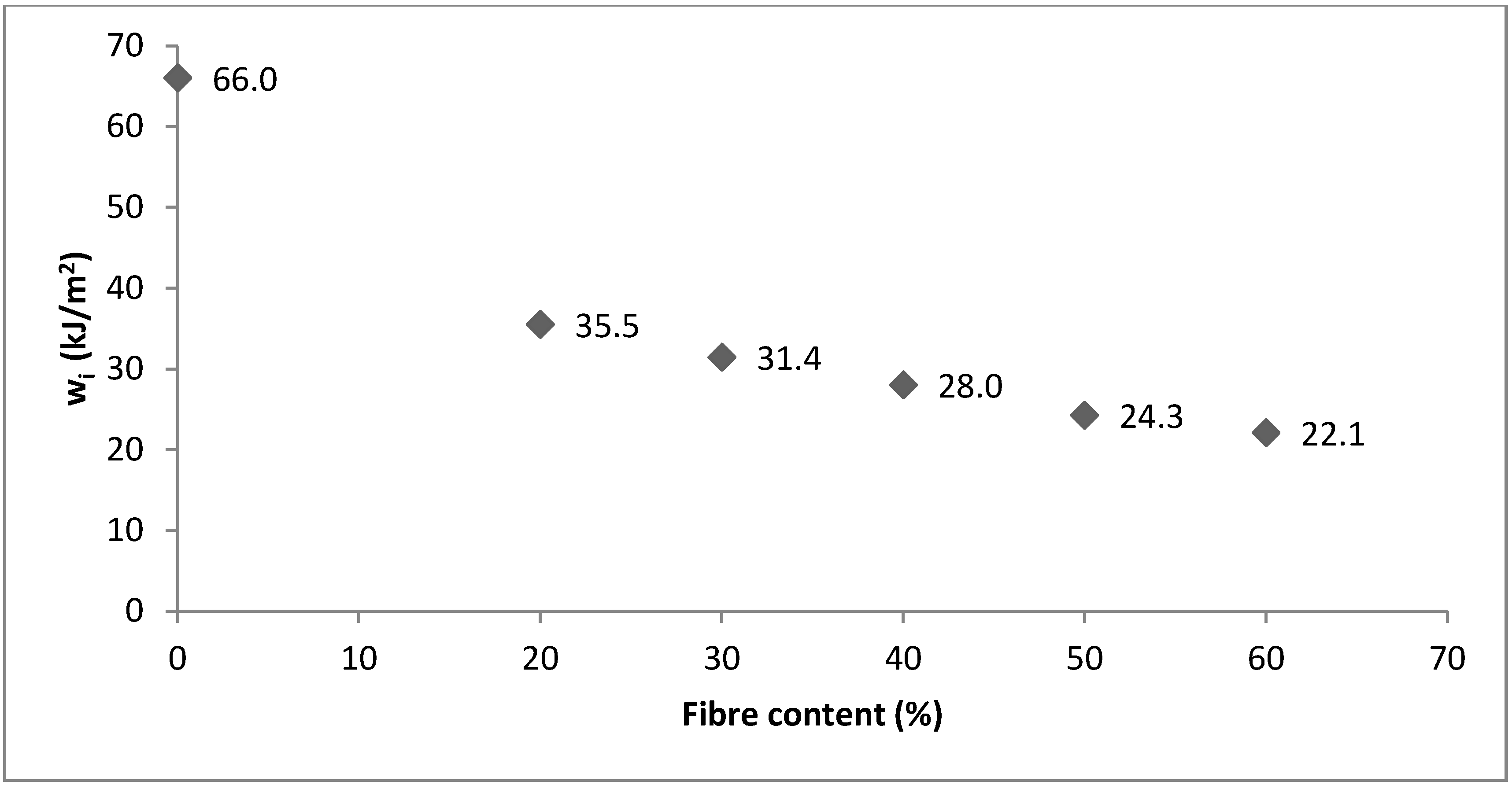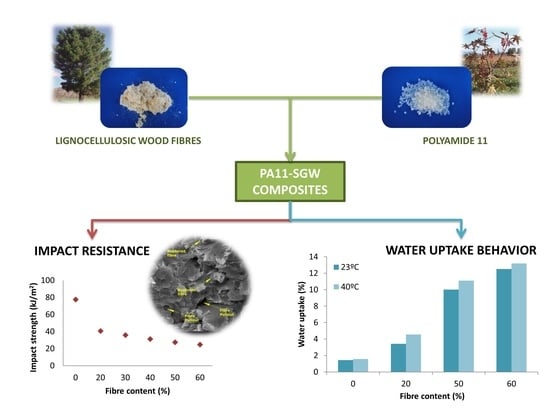Impact Strength and Water Uptake Behaviors of Fully Bio-Based PA11-SGW Composites
Abstract
1. Introduction
2. Materials and Methods
2.1. Materials
2.2. Composite Compounding
2.3. Impact Characterization
2.4. Scanning Electron Microscopy (SEM)
2.5. Hydrophilic Behaviour: Water Contact Angle
2.6. Immersion Water Uptake Test
3. Results
3.1. Impact Strength
3.2. Hydrophility and Water Uptake Behavior at 23 °C and 40 °C
4. Conclusions
Supplementary Materials
Author Contributions
Acknowledgments
Conflicts of Interest
References
- Hristov, V.N.; Lach, R.; Grellmann, W. Impact fracture behavior of modified polypropylene/wood fiber composites. Polym. Test. 2004, 23, 581–589. [Google Scholar] [CrossRef]
- Shibata, S.; Cao, Y.; Fukumoto, I. Study of the flexural modulus of natural fiber/polypropylene composites by injection molding. J. Appl. Polym. Sci. 2006, 100, 911–917. [Google Scholar] [CrossRef]
- López, J.P.; Gironés, J.; Méndez, J.A.; El Mansouri, N.E.; Llop, M.; Mutjé, P.; Vilaseca, F. Stone-ground wood pulp-reinforced polypropylene composites: Water uptake and thermal properties. BioResources 2012, 7, 5478–5487. [Google Scholar] [CrossRef]
- López, J.P.; Gironès, J.; Mendez, J.A.; Pèlach, M.A.; Vilaseca, F.; Mutjé, P. Impact and flexural properties of stone-ground wood pulp-reinforced polypropylene composites. Polym. Compos. 2013, 34, 842–848. [Google Scholar] [CrossRef]
- Oksman, K.; Clemons, C. Mechanical properties and morphology of impact modified polypropylene-wood flour composites. J. Appl. Polym. Sci. 1998, 67, 1503–1513. [Google Scholar] [CrossRef]
- Ruehle, D.A.; Perbix, C.; Castañeda, M.; Dorgan, J.R.; Mittal, V.; Halley, P.; Martin, D. Blends of biorenewable polyamide-11 and polyamide-6,10. Polymer 2013, 54, 6961–6970. [Google Scholar] [CrossRef]
- Oliver-Ortega, H.; Granda, L.A.; Espinach, F.X.; Delgado-Aguilar, M.; Duran, J.; Mutjé, P. Stiffness of bio-based polyamide 11 reinforced with softwood stone ground-wood fibres as an alternative to polypropylene-glass fibre composites. Eur. Polym. J. 2016, 84, 481–489. [Google Scholar] [CrossRef]
- Mancic, L.; Pontón, P.I.; Letichevsky, S.; Costa, A.M.; Marinkovic, B.A.; Rizzo, F.C. Application of silane grafted titanate nanotubes in reinforcing of polyamide 11 composites. Compos. Part B Eng. 2016, 93, 153–162. [Google Scholar] [CrossRef]
- Hocker, S.J.A.; Hudson-Smith, N.V.; Smith, P.T.; Komatsu, C.H.; Dickinson, L.R.; Schniepp, H.C.; Kranbuehl, D.E. Graphene oxide reduces the hydrolytic degradation in polyamide-11. Polymer 2017, 126, 248–258. [Google Scholar] [CrossRef]
- Zierdt, P.; Theumer, T.; Kulkarni, G.; Däumlich, V.; Klehm, J.; Hirsch, U.; Weber, A. Sustainable wood-plastic composites from bio-based polyamide 11 and chemically modified beech fibers. Sustain. Mater. Technol. 2015, 6, 6–14. [Google Scholar] [CrossRef]
- Marrot, L.; Bourmaud, A.; Bono, P.; Baley, C. Multi-scale study of the adhesion between flax fibers and biobased thermoset matrices. Mater. Des. 2014, 62, 47–56. [Google Scholar] [CrossRef]
- Oliver-Ortega, H.; Granda, L.A.; Espinach, F.X.; Méndez, J.A.; Julian, F.; Mutjé, P. Tensile properties and micromechanical analysis of stone groundwood from softwood reinforced bio-based polyamide11 composites. Compos. Sci. Technol. 2016, 132, 123–130. [Google Scholar] [CrossRef]
- Acierno, S.; Van Puyvelde, P. Rheological behavior of polyamide 11 with varying initial moisture content. J. Appl. Polym. Sci. 2005, 97, 666–670. [Google Scholar] [CrossRef]
- Miri, V.; Persyn, O.; Lefebvre, J.-M.; Seguela, R. Effect of water absorption on the plastic deformation behavior of nylon 6. Eur. Polym. J. 2009, 45, 757–762. [Google Scholar] [CrossRef]
- Merdas, I.; Thominette, F.; Tcharkhtchi, A.; Verdu, J. Factors governing water absorption by composite matrices. Compos. Sci. Technol. 2002, 62, 487–492. [Google Scholar] [CrossRef]
- Espert, A.; Vilaplana, F.; Karlsson, S. Comparison of water absorption in natural cellulosic fibres from wood and one-year crops in polypropylene composites and its influence on their mechanical properties. Compos. Part A Appl. Sci. Manuf. 2004, 35, 1267–1276. [Google Scholar] [CrossRef]
- Salazar, A.; Rico, A.; Rodríguez, J.; Segurado Escudero, J.; Seltzer, R.; Martin de la Escalera Cutillas, F. Monotonic loading and fatigue response of a bio-based polyamide PA11 and a petrol-based polyamide PA12 manufactured by selective laser sintering. Eur. Polym. J. 2014, 59, 36–45. [Google Scholar] [CrossRef]
- Arkema Rilsan® Polyamide Family. Available online: https://www.extremematerials-arkema.com/export/sites/technicalpolymers/.content/medias/downloads/brochures/rilsan-brochures/2017-Rilsan-Polyamide-Family-GRANULES-Presentation.pdf (accessed on 6 April 2018).
- Oliver-Ortega, H.; Méndez, J.A.; Mutjé, P.; Tarrés, Q.; Espinach, F.X.; Ardanuy, M. Evaluation of Thermal and Thermomechanical Behaviour of Bio-Based Polyamide 11 Based Composites Reinforced with Lignocellulosic Fibres. Polymers 2017, 9, 522. [Google Scholar] [CrossRef]
- Taylor, J.R. An Introduction to Error Analysis, 2nd ed.; McGuire, A., Ed.; University Science Books: Sausalito, CA, USA, 1997; ISBN 0-935702-42-3. [Google Scholar]
- Granda, L.A.; Espinach, F.X.; Méndez, J.A.; Vilaseca, F.; Delgado-Aguilar, M.; Mutjé, P. Semichemical fibres of Leucaena collinsii reinforced polypropylene composites: Flexural characterisation, impact behaviour and water uptake properties. Compos. Part B Eng. 2016, 97, 176–182. [Google Scholar] [CrossRef]
- Van Krevelen, D.W.; Te Nijenhuis, K. Product Properties (I). In Properties of Polymers; Elsevier: New York, NY, USA, 2009; pp. 819–845. ISBN 9780080548197. [Google Scholar]
- Chantawansri, T.L.; Yeh, I.-C.; Hsieh, A.J. Investigating the glass transition temperature at the atom-level in select model polyamides: A molecular dynamics study. Polymer 2015, 81, 50–61. [Google Scholar] [CrossRef]
- Liu, Z. Effects of coupling agent and morphology on the impact strength of high density polyethylene/CaCO3 composites. Polymer 2002, 43, 2501–2506. [Google Scholar] [CrossRef]
- Cilleruelo, L.; Lafranche, E.; Krawczak, P.; Pardo, P.; Lucas, P. Injection moulding of long glass fibre reinforced poly(ethylene terephtalate): Influence of carbon black and nucleating agents on impact properties. Express Polym. Lett. 2012, 6, 706–718. [Google Scholar] [CrossRef]
- Julian, F.; Méndez, J.A.; Espinach, F.X.; Verdaguer, N.; Mutje, P.; Vilaseca, F. Bio-based composites from stone groundwood applied to new product development. BioResources 2012, 7, 5829–5842. [Google Scholar] [CrossRef]
- Gironès, J.; Lopez, J.P.; Vilaseca, F.; Bayer, R.; Herrera-Franco, P.J.; Mutjé, P. Biocomposites from Musa textilis and polypropylene: Evaluation of flexural properties and impact strength. Compos. Sci. Technol. 2011, 71, 122–128. [Google Scholar] [CrossRef]
- Feldmann, M.; Bledzki, A.K. Bio-based polyamides reinforced with cellulosic fibres—Processing and properties. Compos. Sci. Technol. 2014, 100, 113–120. [Google Scholar] [CrossRef]
- Le Duigou, A.; Bourmaud, A.; Gourier, C.; Baley, C. Multi-scale shear properties of flax fibre reinforced polyamide 11 biocomposites. Compos. Part A Appl. Sci. Manuf. 2016, 85, 123–129. [Google Scholar] [CrossRef]
- Mehrabzadeh, M.; Science, P.; Wales, N.S. Impact Modification of Polyamid 11. J. Appl. Polym. Sci. 1996, 61, 2305–2314. [Google Scholar] [CrossRef]
- Wu, P.; Siesler, H.W. Fourier transform NIR study of liquid diffusion processes in Nylon 11 films: Comparison of water with alcohols. Chem. Mater. 2003, 15, 2752–2756. [Google Scholar] [CrossRef]
- Boukal, I. Effect of water on the mechanism of deformation of nylon 6. J. Appl. Polym. Sci. 1967, 11, 1483–1494. [Google Scholar] [CrossRef]
- Hinrichsen, G. The role of water in polyamides. Colloid Polym. Sci. 1978, 256, 9–14. [Google Scholar] [CrossRef]
- Lopez, J.; Mendez, J.; Espinach, F.; Julian, F.; Mutjé, P.; Vilaseca, F. Tensile strength characteristics of polypropylene composites reinforced with stone groundwood fibres from softwood. Bioresources 2012, 7, 3188–3200. [Google Scholar] [CrossRef]
- Gandini, A. Polymers from renewable resources: A challenge for the future of macromolecular materials. Macromolecules 2008, 41, 9491–9504. [Google Scholar] [CrossRef]
- Busscher, H.J.; van Pelt, A.W.J.; de Boer, P.; de Jong, H.P.; Arends, J. The effect of surface roughening of polymers on measured contact angles of liquids. Colloids Surf. 1984, 9, 319–331. [Google Scholar] [CrossRef]
- Rhim, J.-W.; Mohanty, K.A.; Singh, S.P.; Ng, P.K.W. Preparation and Properties of Biodegradable Multilayer Films Based on Soy Protein Isolate and Poly(lactide). Ind. Eng. Chem. Res. 2006, 45, 3059–3066. [Google Scholar] [CrossRef]
- Lagarón, J.; Giménez, E.; Gavara, R.; Saura, J.; Gime, E. Study of the influence of water sorption in pure components and binary blends of high barrier ethylene–vinyl alcohol copolymer and amorphous polyamide and nylon-containing ionomer. Polymer 2001, 42, 9531–9540. [Google Scholar] [CrossRef]
- Ventura, H.; Claramunt, J.; Rodríguez-Pérez, M.A.; Ardanuy, M. Effects of hydrothermal aging on the water uptake and tensile properties of PHB/flax fabric biocomposites. Polym. Degrad. Stab. 2017, 142, 129–138. [Google Scholar] [CrossRef]
- Reuvers, N.J.W.; Huinink, H.P.; Fischer, H.R.; Adan, O.C.G. Quantitative water uptake study in thin nylon-6 films with NMR imaging. Macromolecules 2012, 45, 1937–1945. [Google Scholar] [CrossRef]
- Pepin, J.; Miri, V.; Lefebvre, J.-M. New Insights into the Brill Transition in Polyamide 11 and Polyamide 6. Macromolecules 2016, 49, 564–573. [Google Scholar] [CrossRef]
- Goudeau, S.; Charlot, M.; Müller-Plathe, F. Mobility Enhancement in Amorphous Polyamide 6,6 Induced by Water Sorption: A Molecular Dynamics Simulation Study. J. Phys. Chem. B 2004, 108, 18779–18788. [Google Scholar] [CrossRef]
- Jacques, B.; Werth, M.; Merdas, I.; Thominette, F.; Verdu, J. Hydrolytic ageing of polyamide 11. 1. Hydrolysis kinetics in water. Polymer 2002, 43, 6439–6447. [Google Scholar] [CrossRef]
- Meyer, A.; Jones, N.; Lin, Y.; Kranbuehl, D. Characterizing and modeling the hydrolysis of polyamide-11 in a pH 7 water environment. Macromolecules 2002, 35, 2784–2798. [Google Scholar] [CrossRef]


| Fiber Content (%) | Charpy Impact Strength | |
|---|---|---|
| Un-Notched (kJ/m2) | Notched (kJ/m2) | |
| 0 | 77.5 ± 8.5 | 11.5 ± 1.9 |
| 20 | 40.8 ± 7.5 | 5.2 ± 0.2 |
| 30 | 35.8 ± 7.7 | 4.4 ± 0.2 |
| 40 | 31.4 ± 2.9 | 3.3 ± 0.2 |
| 50 | 27.4 ± 1.4 | 3.2 ± 0.2 |
| 60 | 24.8 ± 1.2 | 2.7 ± 0.1 |
| Sample | Average Contact Angle (°) | Ew (mJ/m2) |
|---|---|---|
| PA11 | 77.1 ± 0.4 | 16.3 ± 0.5 |
| PA11 + 20%SGW | 68.8 ± 0.4 | 26.3 ± 0.5 |
| PA11 + 50%SGW | 65.9 ± 0.5 | 29.7 ± 0.6 |
| PA11 + 60%SGW | 69.3 ± 1.3 | 25.7 ± 1.5 |
| Temperature (°C) | Fiber Content (%) | M∞ (%) | n | K | D (10−13 m2·s−1) |
|---|---|---|---|---|---|
| 23 | 0 | 1.43 ± 0.02 | 0.305 ± 0.045 | 0.088 ± 0.023 | 4.95 ± 0.02 |
| 20 | 3.42 ± 0.03 | 0.371 ± 0.006 | 0.04 ± 0.002 | 2.19 ± 0.01 | |
| 50 | 10.01 ± 0.25 | 0.428 ± 0.004 | 0.03 ± 0.001 | 2.70 ± 0.02 | |
| 60 | 12.51 ± 0.30 | 0.453 ± 0.002 | 0.043 ± 0.001 | 5.81 ± 0.47 | |
| 40 | 0 | 1.58 ± 0.03 | 0.272 ± 0.007 | 0.155 ± 0.007 | 22.00 ± 1.65 |
| 20 | 4. 55 ± 0.10 | 0.387 ± 0.010 | 0.059 ± 0.004 | 6.02 ± 0.04 | |
| 50 | 11.10 ± 0.20 | 0.419 ± 0.004 | 0.057 ± 0.002 | 8.05 ± 0.06 | |
| 60 | 13.20 ± 0.02 | 0.481 ± 0.006 | 0.055 ± 0.003 | 14.44 ± 0.44 |
| Fiber Content (%) | Ed (kJ/mol) |
|---|---|
| 0 | 68 |
| 20 | 46 |
| 50 | 49 |
| 60 | 41 |
© 2018 by the authors. Licensee MDPI, Basel, Switzerland. This article is an open access article distributed under the terms and conditions of the Creative Commons Attribution (CC BY) license (http://creativecommons.org/licenses/by/4.0/).
Share and Cite
Oliver-Ortega, H.; Méndez, J.A.; Espinach, F.X.; Tarrés, Q.; Ardanuy, M.; Mutjé, P. Impact Strength and Water Uptake Behaviors of Fully Bio-Based PA11-SGW Composites. Polymers 2018, 10, 717. https://doi.org/10.3390/polym10070717
Oliver-Ortega H, Méndez JA, Espinach FX, Tarrés Q, Ardanuy M, Mutjé P. Impact Strength and Water Uptake Behaviors of Fully Bio-Based PA11-SGW Composites. Polymers. 2018; 10(7):717. https://doi.org/10.3390/polym10070717
Chicago/Turabian StyleOliver-Ortega, Helena, José Alberto Méndez, Francesc Xavier Espinach, Quim Tarrés, Mònica Ardanuy, and Pere Mutjé. 2018. "Impact Strength and Water Uptake Behaviors of Fully Bio-Based PA11-SGW Composites" Polymers 10, no. 7: 717. https://doi.org/10.3390/polym10070717
APA StyleOliver-Ortega, H., Méndez, J. A., Espinach, F. X., Tarrés, Q., Ardanuy, M., & Mutjé, P. (2018). Impact Strength and Water Uptake Behaviors of Fully Bio-Based PA11-SGW Composites. Polymers, 10(7), 717. https://doi.org/10.3390/polym10070717











